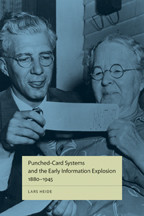
Reviews
Coopersmith provides an illuminating, meticulously researched and often fascinating account.
Archival research and interviews were used to reveal this lost history, while a tone designed to entertain as well as inform lends to a survey highly recommended for any interested in technological advancement and business history.
Coopersmith tells his story clearly with ample attention both to technical detail and wider context, and notably with an eye to the comparative evolution of fax in different national contexts. It is highly recommended to readers.
This book should be part of any history of technology collection. It also provides an interesting read for general audiences.
[The] breadth of coverage alone makes Faxed an important contribution to the history of communications technologies, and provides a strong foundation for further work that digs deeper into particular time period, devices, or markets.
... Each invention deserves at least one good book, and Coppersmith has written the fax machine’s definitive history here.
Based on an immense body of material collected from archives across three continents, Faxed provides a model of transnational scholarship and represents a major addition to the histories of communication and information technology.
Juxtaposing the obvious and the obscure, the momentous and the mundane, Coopersmith leads us inside the black box of fax history, and we emerge with fresh perspectives of one technology whose time has passed but legacy remains.
The most important lesson of Faxed is that the real history of technology is inherently messy, and the complicated history captured in this book—which can be admired through the 1,148 footnotes in the back matter—is testimony to that inescapable fact. If you wish to know anything about the history of fax technology, it is highly probable that you will find it in this encyclopedic treatment.
We are fortunate that the author took the time to complete this book, because our understanding of the history of faxing, and of the history of modern technology in general, is much richer for it.
... This work is meticulously researched and the information astutely synthesized. Those with a strong interest in the history of technology will be richly rewarded.
An impressive amount of primary research has gone into writing Faxed, the definitive life history of the fax machine. Scholars of information and communication technology, especially historians, will be interested in this fascinating story of a uniquely persistent digital technology.
Book Details
Preface
Abbreviations
Introduction
1. First Patent to First World War, 1843–1918
2. First Markets, 1918–1939
3. Facsimile, 1939–1965
4. The Sleeping Giant Stirs, 1965–1980
5. The Giant Awakes, 1980–1995
6
Preface
Abbreviations
Introduction
1. First Patent to First World War, 1843–1918
2. First Markets, 1918–1939
3. Facsimile, 1939–1965
4. The Sleeping Giant Stirs, 1965–1980
5. The Giant Awakes, 1980–1995
6. The Fax and the Computer
Conclusion
Notes
Essay on Sources
Index






